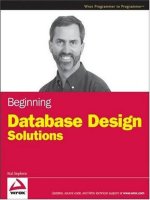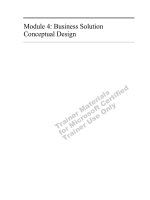Begin databse design solution 2009
Bạn đang xem bản rút gọn của tài liệu. Xem và tải ngay bản đầy đủ của tài liệu tại đây (6.12 MB, 552 trang )
Beginning
Database Design Solutions
Enhance Your Knowledge
Advance Your Career
Professional Microsoft SQL Server 2008 Integration
Services
978-0-470-24795-2
This book shows developers how to master the 2008 release of SSIS,
covering topics including data warehousing with SSIS, new methods of
managing the SSIS platform, and improved techniques for ETL operations.
Professional SQL Server 2008 Reporting Services
978-0-470-24201-8
This book teaches solutions architects, designers, and developers how
to use Microsoft’s reporting platform to create reporting and business
intelligence solutions.
Professional Microsoft SQL Server 2008 Analysis Services
978-0-470-24798-3
Professional Microsoft SQL Server 2008 Analysis Services shows readers
how to build data warehouses and multidimensional databases, query
databases, and use Analysis Services and other components of SQL Server
to provide end-to-end solutions.
Professional Microsoft SQL Server 2008 Programming
978-0-470-25702-9
This updated new edition of Wrox’s best-selling SQL Server book has been
expanded to include coverage of SQL Server 2008’s new datatypes, new
indexing structures, manageability features, and advanced time-zone
handling.
Professional Microsoft SQL Server 2008 Administration
978-0-470-24796-9
A how-to guide for experienced database administrators, this book is loaded
with unique tips, tricks, and workarounds for handling the most difficult SQL Server administration issues. The authors discuss
data capture, performance studio, Query Governor, and new techniques for monitoring and policy management.
Beginning Microsoft SQL Server 2008 Programming
978-0-470-25701-2
This comprehensive introduction to SQL Server covers the fundamentals and moves on to discuss how to create and change
tables, manage keys, write scripts, work with stored procedures, and much more.
Beginning T-SQL with Microsoft SQL Server 2005 and 2008
978-0-470-25703-6
Beginning T-SQL with Microsoft SQL Server 2005 and 2008 provides a comprehensive introduction to the T-SQL programming
language, with concrete examples showing how T-SQL works with both SQL Server 2005 and SQL Server 2008.
Beginning Database Design Solutions
978-0-470-38549-4
Beginning Database Design Solutions introduces IT professionals—both DBAs and database developers—to database design.
It explains what databases are, their goals, and why proper design is necessary to achieve those goals. It tells how to decide
what should be in a database to meet the application’s requirements. It tells how to structure the database so it gives good
performance while minimizing the chance for error.
Get more out of
WROX.com
Programmer to Programmer
™
Interact
Take an active role online by participating in
our P2P forums
Wrox Online Library
Hundreds of our books are available online
through Books24x7.com
Wrox Blox
Download short informational pieces and
code to keep you up to date and out of
trouble!
Chapters on Demand
Purchase individual book chapters in pdf
format
Join the Community
Sign up for our free monthly newsletter at
newsletter.wrox.com
Browse
Ready for more Wrox? We have books and
e-books available on .NET, SQL Server, Java,
XML, Visual Basic, C#/ C++, and much more!
Contact Us.
We always like to get feedback from our readers. Have a book idea?
Need community support? Let us know by e-mailing
spine=1.10"
Stephens ffirs.tex V3 - 10/03/2008 4:09am Page i
Beginning
Database Design Solutions
Introduction
.....................................................................
xxiii
Part I: Introduction to Databases and Database Design 1
Chapter 1: Goals of Effective Database Design
..........................................
3
Chapter 2: Database Types
.........................................................
23
Chapter 3: Relational Database Fundamentals
........................................
49
Part II: Database Design Process and Techniques 63
Chapter 4: Understanding User Needs
...............................................
65
Chapter 5: Translating User Needs into Data Models
..................................
89
Chapter 6: Extracting Business Rules
...............................................
121
Chapter 7: Normalizing Data
.......................................................
137
Chapter 8: Designing Databases to Support Software Applications
.....................
173
Chapter 9: Common Design Patterns
...............................................
185
Chapter 10: Common Design Pitfalls
................................................
207
Part III: A Detailed Case Study 225
Chapter 11: User Needs and Requirements
..........................................
227
Chapter 12: Building a Data Model
.................................................
245
Chapter 13: Extracting Business Rules
.............................................
263
Chapter 14: Normalization and Refinement
..........................................
273
Part IV: Implementing Databases (with Examples in Access
and MySQL) 285
Chapter 15: Microsoft Access
.....................................................
287
Chapter 16: MySQL
...............................................................
313
Part V: Advanced Topics 343
Chapter 17: Introduction to SQL
....................................................
345
Chapter 18: Building Databases with SQL Scripts
....................................
369
Chapter 19: Database Maintenance
................................................
379
Chapter 20: Database Security
.....................................................
389
Appendix A: Exercise Solutions
....................................................
403
Appendix B: Sample Database Designs
.............................................
467
Glossary
.........................................................................
487
Index
...........................................................................
497
Stephens ffirs.tex V3 - 10/03/2008 4:09am Page ii
Stephens ffirs.tex V3 - 10/03/2008 4:09am Page iii
Beginning
Database Design Solutions
Stephens ffirs.tex V3 - 10/03/2008 4:09am Page iv
Stephens ffirs.tex V3 - 10/03/2008 4:09am Page v
Beginning
Database Design Solutions
Rod Stephens
Wiley Publishing, Inc.
Stephens ffirs.tex V3 - 10/03/2008 4:09am Page vi
Beginning Database Design Solutions
Published by
Wiley Publishing, Inc.
10475 Crosspoint Boulevard
Indianapolis, IN 46256
www.wiley.com
Copyright 2009 by Wiley Publishing, Inc., Indianapolis, Indiana
Published simultaneously in Canada
ISBN: 978-0-470-38549-4
Manufactured in the United States of America
10987654321
Library of Congress Cataloging-in-Publication Data
Stephens, Rod, 1961-
Beginning database design solutions / Rod Stephens.
p. cm.
Includes index.
ISBN 978-0-470-38549-4 (978-0-470-38549-4)
1. Database design. 2. Databases. I. Title.
QA76.9.D26S97 2008
005.74 — dc22
2008037282
No part of this publication may be reproduced, stored in a retrieval system or transmitted in any form or by any
means, electronic, mechanical, photocopying, recording, scanning or otherwise, except as permitted under Sections
107 or 108 of the 1976 United States Copyright Act, without either the prior written permission of the Publisher, or
authorization through payment of the appropriate per-copy fee to the Copyright Clearance Center, 222 Rosewood
Drive, Danvers, MA 01923, (978) 750-8400, fax (978) 646-8600. Requests to the Publisher for permission should be
addressed to the Legal Department, Wiley Publishing, Inc., 10475 Crosspoint Blvd., Indianapolis, IN 46256, (317)
572-3447, fax (317) 572-4355, or online at
/>.
Limit of Liability/Disclaimer of Warranty: The publisher and the author make no representations or warranties
with respect to the accuracy or completeness of the contents of this work and specifically disclaim all warranties,
including without limitation warranties of fitness for a particular purpose. No warranty may be created or extended
by sales or promotional materials. The advice and strategies contained herein may not be suitable for every
situation. This work is sold with the understanding that the publisher is not engaged in rendering legal, accounting,
or other professional services. If professional assistance is required, the services of a competent professional person
should be sought. Neither the publisher nor the author shall be liable for damages arising herefrom. The fact that an
organization or Web site is referred to in this work as a citation and/or a potential source of further information
does not mean that the author or the publisher endorses the information the organization or Web site may provide
or recommendations it may make. Further, readers should be aware that Internet Web sites listed in this work may
have changed or disappeared between when this work was written and when it is read.
For general information on our other products and services please contact our Customer Care Department within the
United States at (800) 762-2974, outside the United States at (317) 572-3993 or fax (317) 572-4002.
Trademarks: Wiley, the Wiley logo, Wrox, the Wrox logo, Wrox Programmer to Programmer, and related trade dress
are trademarks or registered trademarks of John Wiley & Sons, Inc. and/or its affiliates, in the United States and
other countries, and may not be used without written permission. All other trademarks are the property of their
respective owners. Wiley Publishing, Inc., is not associated with any product or vendor mentioned in this book.
Wiley also publishes its books in a variety of electronic formats. Some content that appears in print may not be
available in electronic books.
Stephens f01.tex V3 - 10/01/2008 3:23am Page vii
About the Author
Rod Stephens started out as a mathematician but, while studying at MIT, discovered the joys of computer
algorithms and programming and he’s been programming professionally ever since. During his career,
he has worked on a wide variety of applications in such diverse fields as telephone switching, billing,
repair dispatching, tax processing, wastewater treatment, concert ticket sales, cartography, and training
for professional football players.
Rod is a Microsoft Visual Basic Most Valuable Professional (MVP), consultant and author. He has written
18 books that have been translated into half a dozen different languages, and more than 250 magazine
articles, mostly about Visual Basic. Currently he is a regular contributor of C# and Visual Basic articles at
DevX.com (
www.devx.com
).
Rod’s popular VB Helper Web site
www.vb-helper.com
receives several million hits per month and con-
tains thousands of pages of tips, tricks, and example code for Visual Basic programmers, as well as
example code for this book.
Stephens f01.tex V3 - 10/01/2008 3:23am Page viii
Stephens f02.tex V3 - 10/01/2008 3:23am Page ix
Credits
Executive Editor
Robert Elliott
Development Editor
Sydney Jones
Technical Editor
Steve Hoberman
Production Editor
Angela Smith
Copy Editor
Kim Cofer
Editorial Manager
Mary Beth Wakefield
Production Manager
Tim Tate
Vice President and Executive Group Publisher
Richard Swadley
Vice President and Executive Publisher
Joseph B. Wikert
Project Coordinator, Cover
Lynsey Stanford
Proofreader
Publication Services, Inc.
Indexer
Jack Lewis
Stephens f02.tex V3 - 10/01/2008 3:23am Page x
Stephens f03.tex V3 - 10/01/2008 3:25am Page xi
Acknowledgments
Thanks to Bob Elliott, Sydney Jones, Steve Hoberman, and all of the others whose hard work went into
producing this book.
Special thanks to Sydney Jones for putting up with my sometimes overly generous interpretation of the
Wrox guidelines.
Stephens f03.tex V3 - 10/01/2008 3:25am Page xii
Stephens ftoc.tex V2 - 10/03/2008 4:13am Page xiii
Contents
Introduction xxiii
Part I: Introduction to Databases and Database Design
Chapter 1: Goals of Effective Database Design 3
Understanding the Importance of Design 4
Information Containers 5
Strengths and Weaknesses of Information Containers 7
Desirable Database Features 8
CRUD 9
Retrieval 9
Consistency 10
Validity 10
Easy Error Correction 11
Speed 11
Atomic Transactions 12
ACID 13
Persistence and Backups 14
Low Cost and Extensibility 16
Ease of Use 16
Portability 16
Security 17
Sharing 18
Ability to Perform Complex Calculations 19
Consequences of Good and Bad Design 19
Summary 21
Exercises 22
Chapter 2: Database Types 23
Why Bother? 24
Flat Files 24
INI Files 26
Windows System Registry 26
Relational Databases 27
Stephens ftoc.tex V2 - 10/03/2008 4:13am Page xiv
Contents
Spreadsheets 30
Hierarchical Databases 31
XML 34
XML Basics 34
XML Structures 37
XML Summary 39
Network 40
Object 42
Object-Relational 43
Exotic 44
Document-Oriented 44
Deductive 44
Dimensional 44
Temporal 45
Summary 45
Exercises 47
Chapter 3: Relational Database Fundamentals 49
Relational Points of View 49
Table, Rows, and Columns 50
Relations, Attributes, and Tuples 52
Keys 52
Indexes 54
Constraints 55
Basic Constraints 55
Check Constraints 55
Primary Key Constraints 55
Unique Constraints 56
Foreign Key Constraints 56
Database Operations 57
Summary 59
Exercises 59
Part II: Database Design Process and Techniques
Chapter 4: Understanding User Needs 65
Make a Plan 66
Bring a List of Questions 67
Functionality 67
Data Needs 67
Data Integrity 68
xiv
Stephens ftoc.tex V2 - 10/03/2008 4:13am Page xv
Contents
Security 68
Environment 69
Meet the Customers 69
Learn Who’s Who 70
Pick the Customers’ Brains 73
Walk a Mile in the User’s Shoes 73
Study Current Operations 74
Brainstorm 75
Look to the Future 76
Understand the Customers’ Reasoning 76
Learn What the Customers Really Need 77
Prioritize 78
Verify Your Understanding 79
Write the Requirements Document 80
Make Use Cases 81
Decide Feasibility 85
Summary 85
Exercises 86
Chapter 5: Translating User Needs into Data Models 89
What Are Data Models? 90
User Interface Models 92
Semantic Object Models 96
Classes and Objects 96
Cardinality 97
Identifiers 97
Putting It Together 97
Semantic Views 99
Class Types 100
Comments and Notes 106
Entity-Relationship Models 106
Entities, Attributes, and Identifiers 107
Relationships 107
Cardinality 108
Inheritance 109
Additional Conventions 112
Comments and Notes 113
Relational Models 113
Converting Semantic Object Models 113
Converting ER Diagrams 116
Summary 117
Exercises 118
xv
Stephens ftoc.tex V2 - 10/03/2008 4:13am Page xvi
Contents
Chapter 6: Extracting Business Rules 121
What Are Business Rules? 121
Identifying Key Business Rules 123
Extracting Key Business Rules 128
Multi-Tier Applications 129
Summary 133
Exercises 134
Chapter 7: Normalizing Data 137
What Is Normalization? 137
First Normal Form (1NF) 138
Second Normal Form (2NF) 146
Third Normal Form (3NF) 150
Stopping at Third Normal Form 154
Boyce-Codd Normal Form (BCNF) 154
Fourth Normal Form (4NF) 158
Fifth Normal Form (5NF) 162
Domain/Key Normal Form (DKNF) 165
Essential Redundancy 167
The Best Level of Normalization 168
Summary 169
Exercises 170
Chapter 8: Designing Databases to Support Software Applications 173
Plan Ahead 173
Document Everything 174
Consider Multi-Tier Architecture 175
Convert Domains into Tables 175
Keep Tables Focused 176
Use Three Kinds of Tables 176
Use Naming Conventions 178
Allow Some Redundant Data 179
Don’t Squeeze in Everything 180
Summary 181
Exercises 182
Chapter 9: Common Design Patterns 185
Associations 185
Many-to-Many Associations 186
Multiple Many-to-Many Associations 186
xvi
Stephens ftoc.tex V2 - 10/03/2008 4:13am Page xvii
Contents
Multiple-Object Associations 188
Repeated Attribute Associations 191
Reflexive Associations 193
Temporal Data 200
Effective Dates 200
Deleted Objects 202
Deciding What to Temporalize 203
Logging and Locking 203
Audit Trails 203
Turnkey Records 204
Summary 205
Exercises 205
Chapter 10: Common Design Pitfalls 207
Lack of Preparation 207
Poor Documentation 208
Poor Naming Standards 208
Thinking Too Small 210
Not Planning for Change 210
Too Much Normalization 213
Insufficient Normalization 213
Insufficient Testing 214
Performance Anxiety 214
Mishmash Tables 215
Not Enforcing Constraints 217
Obsession with IDs 218
Not Defining Natural Keys 220
Summary 221
Exercises 222
Part III: A Detailed Case Study
Chapter 11: User Needs and Requirements 227
Meet the Customers 227
Pick the Customers’ Brains 229
Determining What the System Should Do 229
Determining How the Project Should Look 231
Determining What Data Is Needed for the User Interface 232
Determining Where the Data Should Come From 233
Determining How the Pieces of Data Are Related 233
Determining Performance Needs 235
xvii
Stephens ftoc.tex V2 - 10/03/2008 4:13am Page xviii
Contents
Determining Security Needs 236
Determining Data Integrity Needs 236
Write Use Cases 238
Write the Requirements Document 242
Demand Feedback 243
Summary 244
Exercises 244
Chapter 12: Building a Data Model 245
Semantic Object Modeling 245
Building an Initial Semantic Object Model 245
Improving the Semantic Object Model 248
Entity-Relationship Modeling 250
Building an ER Diagram 250
Building a Combined ER Diagram 252
Improving the Entity-Relationship Diagram 254
Relational Modeling 256
Putting It All Together 259
Summary 260
Exercises 261
Chapter 13: Extracting Business Rules 263
Identifying Business Rules 263
Courses 264
CustomerCourses 266
Customers 267
Pets 267
Employees 267
Orders 267
OrderItems 268
InventoryItems 268
TimeEntries 268
Shifts 269
Persons 269
Phones 269
Vendors 269
Drawing a New Relational Model 270
Summary 270
Exercises 271
xviii
Stephens ftoc.tex V2 - 10/03/2008 4:13am Page xix
Contents
Chapter 14: Normalization and Refinement 273
Improving Flexibility 273
Verifying First Normal Form 275
Verifying Second Normal Form 278
Pets 279
TimeEntries 280
Verifying Third Normal Form 281
Summary 283
Exercises 284
Part IV: Implementing Databases
(with Examples in
Access and MySQL)
Chapter 15: Microsoft Access 287
Understanding Access 287
Getting Started 288
Defining Relationships 293
Creating Field Constraints 296
Creating Table Constraints 298
Creating Queries 301
Query Design View 304
SQL View 306
Summary 308
Exercises 308
Chapter 16: MySQL 313
Installing MySQL 313
Using MySQL Command Line Client 314
Executing SQL Scripts 318
Using MySQL Query Browser 319
Executing Queries 320
Editing Data 320
Creating and Modifying Databases 321
Using Scripts 327
Getting Syntax Help 329
Using MySQL Workbench 330
Loading Scripts 330
Creating EER Diagrams 331
xix
Stephens ftoc.tex V2 - 10/03/2008 4:13am Page xx
Contents
Editing Databases 333
Defining Triggers 334
Exporting Scripts 336
Summary 338
Exercises 338
Part V: Advanced Topics
Chapter 17: Introduction to SQL 345
Background 345
Finding More Information 346
Standards 346
Basic Syntax 347
Command Overview 348
CREATE TABLE 350
CREATE INDEX 355
DROP 356
INSERT 357
SELECT 358
SELECT Clause 358
FROM Clause 359
WHERE Clause 362
GROUP BY Clause 362
ORDER BY Clause 363
UPDATE 364
DELETE 365
Summary 366
Exercises 366
Chapter 18: Building Databases with SQL Scripts 369
Why Bother with Scripts? 369
Script Categories 370
Database Creation Scripts 370
Basic Initialization Scripts 370
Data Initialization Scripts 370
Cleanup Scripts 371
Saving Scripts 371
Ordering SQL Commands 371
Summary 376
Exercises 377
xx
Stephens ftoc.tex V2 - 10/03/2008 4:13am Page xxi
Contents
Chapter 19: Database Maintenance 379
Backups 379
Data Warehousing 382
Repairing the Database 383
Compacting the Database 383
Performance Tuning 383
Summary 386
Exercises 387
Chapter 20: Database Security 389
The Right Level of Security 389
Passwords 390
Single-Password Databases 390
Individual Passwords 390
Operating System Passwords 391
Good Passwords 391
Privileges 392
Initial Configuration and Privileges 398
Too Much Security 398
Physical Security 399
Summary 400
Exercises 401
Appendix A: Exercise Solutions 403
Chapter 1 403
Chapter 2 408
Chapter 3 411
Chapter 4 413
Chapter 5 417
Chapter 6 424
Chapter 7 430
Chapter 8 434
Chapter 9 436
Chapter 10 440
Chapter 11 442
Chapter 12 446
Chapter 13 449
Chapter 14 451
Chapter 15 454
xxi
Stephens ftoc.tex V2 - 10/03/2008 4:13am Page xxii
Contents
Chapter 16 454
Chapter 17 454
Chapter 18 457
Chapter 19 459
Chapter 20 460
Appendix B: Sample Database Designs 467
Books 468
DVD and Movies 470
Music and CDs 471
Documents 472
Customer Orders 472
Employee Shifts and Timesheets 473
Employees, Projects, and Departments 473
Employee Skills and Qualifications 475
Identical Object Rental 476
Distinct Object Rental 476
Students, Courses, and Grades 478
Teams 479
Individual Sports 480
Vehicle Fleets 480
Contacts 483
Passengers 483
Recipes 485
Glossary 487
Index 497
xxii
Stephens f04.tex V3 - 10/01/2008 3:41am Page xxiii
Introduction
It has been estimated that more than 80 percent of all computer programming is database-related. This
is certainly easy to believe. After all, a database can be a powerful tool for doing exactly what computer
programs do best: store, manipulate, and display data.
Even many programs that seem at first glance to have little to do with traditional business-oriented
data use databases to make processing easier. In fact, looking back on more than 20 years of software
development experience, I’m hard pressed to think of a single non-trivial application that I’ve worked on
that didn’t use some kind of database.
Not only do databases play a role in many applications, but they also often play a critical role. If the data
is not properly stored, it may become corrupted and the program will be unable to use it meaningfully.
If the data is not properly organized, the program may be unable to find what it needs in a reasonable
amount of time.
Unless the database stores its data safely and effectively, the application will be useless no matter how
well-designed the rest of the system may be. The database is like the foundation of a building: without a
strong foundation, even the best crafted building will fail, sometimes spectacularly (the Leaning Tower
of Pisa notwithstanding).
With such a large majority of applications relying so heavily on databases, you would expect every-
one involved with application development to have a solid, formal foundation in database design and
construction. Everyone including database designers, application architects, programmers, database
administrators, and project managers should ideally understand what makes a good database design.
Even an application’s key customers and users could benefit from understanding how databases work.
Sadly that is usually not the case. Many IT professionals have learned what they know about databases
through rumor, trial-and-error, and painful experience. Over the years, some develop an intuitive feel
for what makes a good database design but they may still not understand the reasons why a design is
good or bad, and they may leave behind a trail of rickety, poorly constructed programs built on shaky
database foundations.
This book provides the tools you need to design a database. It explains how to determine what should
go in a database and how a database should be organized to ensure data integrity and a reasonable
level of performance. It explains techniques for designing a database that is strong enough to store data
safely and consistently, flexible enough to allow the application to retrieve the data it needs quickly and
reliably, and adaptable enough to accommodate a realistic amount of change.









